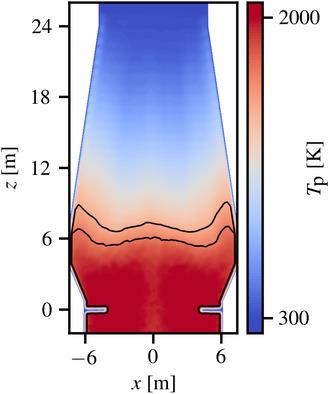当前位置:
X-MOL 学术
›
Steel Res. Int.
›
论文详情
Our official English website, www.x-mol.net, welcomes your feedback! (Note: you will need to create a separate account there.)
Toward Data‐Assisted Particle‐Fluid Simulations of Heat Transfer in Blast Furnaces
Steel Research International ( IF 2.2 ) Pub Date : 2020-05-14 , DOI: 10.1002/srin.202000132 Thomas Lichtenegger 1, 2 , Stefan Pirker 1, 2
Steel Research International ( IF 2.2 ) Pub Date : 2020-05-14 , DOI: 10.1002/srin.202000132 Thomas Lichtenegger 1, 2 , Stefan Pirker 1, 2
Affiliation

|
Detailed particle‐fluid simulations of moving bed reactors such as blast furnaces (BFs) are computationally very expensive. The wide range of temporal scales from short‐lived micromechanics to slow, macroscopic transport makes it almost impossible to study e.g., heat transfer over process‐relevant time scales. However, a recently introduced approach that uses high‐fidelity data obtained with the discrete element method (DEM) enables extremely fast data‐assisted simulations. Using this methodology, calculations are conducted, which are efficient enough to study granular motion through a BF slot model subject to heat transfer between the hot blast and the solid phase over many hours. These long durations make it possible to determine the thermal steady state including shape and location of the cohesive zone (CZ). While other approaches either have to predefine its properties or are bound to very small domain sizes, this novel strategy is applied to a large‐scale BF slot model with about 28 m height and 15 m width with hardly any prior knowledge. It constitutes an important step toward virtual experiments on BFs under realistic conditions and will allow researchers to gain new insights, perform variations of operating parameters, and ultimately build an online monitoring system.
中文翻译:

迈向高炉传热的数据辅助粒子流模拟
移动床反应器(如高炉(BFs))的详细颗粒-流体模拟在计算上非常昂贵。从短暂的微力学到缓慢的宏观传输,时间尺度的范围很广,这使得几乎无法研究例如与过程相关的时间尺度上的热传递。但是,最近引入的一种使用通过离散元素方法(DEM)获得的高保真数据的方法可以实现极快的数据辅助仿真。使用这种方法进行计算,其效率足以研究通过BF缝隙模型的颗粒运动,而该模型受热风和固相之间的传热历时数小时之久。这些长的持续时间使得可以确定热稳定状态,包括粘结区域(CZ)的形状和位置。尽管其他方法要么必须预先定义其属性,要么必须绑定到非常小的域大小,但是这种新颖的策略几乎不需要任何先验知识即可应用于高度约为28 m,宽度为15 m的大型BF槽模型。它构成了在现实条件下进行高炉虚拟实验的重要一步,将使研究人员获得新见解,执行操作参数的变化并最终构建在线监控系统。
更新日期:2020-05-14
中文翻译:

迈向高炉传热的数据辅助粒子流模拟
移动床反应器(如高炉(BFs))的详细颗粒-流体模拟在计算上非常昂贵。从短暂的微力学到缓慢的宏观传输,时间尺度的范围很广,这使得几乎无法研究例如与过程相关的时间尺度上的热传递。但是,最近引入的一种使用通过离散元素方法(DEM)获得的高保真数据的方法可以实现极快的数据辅助仿真。使用这种方法进行计算,其效率足以研究通过BF缝隙模型的颗粒运动,而该模型受热风和固相之间的传热历时数小时之久。这些长的持续时间使得可以确定热稳定状态,包括粘结区域(CZ)的形状和位置。尽管其他方法要么必须预先定义其属性,要么必须绑定到非常小的域大小,但是这种新颖的策略几乎不需要任何先验知识即可应用于高度约为28 m,宽度为15 m的大型BF槽模型。它构成了在现实条件下进行高炉虚拟实验的重要一步,将使研究人员获得新见解,执行操作参数的变化并最终构建在线监控系统。



























 京公网安备 11010802027423号
京公网安备 11010802027423号